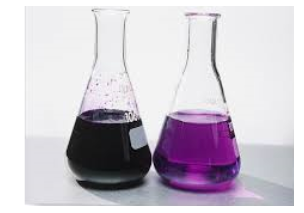.png)
Sodium permanganate is the inorganic compound with the formula NaMnO4. It is closely related to potassium permanganate and behaves similarly to potassium permanganate. It dissolves readily in water to give deep purple solutions, evaporation of which gives prismatic purple-black glistening crystals of the monohydrate NaMnO4·H2O.

Grades and Specifications
| Description | Standards |
|---|---|
| Appearance | Dark Purple color Liquid |
| Assay as NaMnO4 | >20% |
| pH of solution | 6 to 8 |
| Specific Gravity | 1.16 to 1.17gm/cc |
| Chloride (Cl) | 0.01 % |
| Sulphate (SO4) | 0.01 % |
| Potassium as K | 0.10% |
| Heavy Metals(Ag,As,Be,Cd,Cr,Cu,Hg,Pb,Ni,Sb,Se,Ti,Zn) | Less than 10 PPM |
| Description | Standards |
|---|---|
| Appearance | Dark Purple color Liquid |
| Assay as NaMnO4 | >40% |
| pH of solution | 6 to 8 |
| Specific Gravity | 1.37 to 1.39gm/cc |
| Chloride (Cl) | 0.01 % |
| Sulphate (SO4) | 0.02 % |
| Potassium as K | 0.15% |
| Heavy Metals(Ag,As,Be,Cd,Cr,Cu,Hg,Pb,Ni,Sb,Se,Ti,Zn) | Less than 10 PPM |
TECHNICAL DATA
| Description | Standards |
|---|---|
| Molecular Formula | NaMnO4 |
| Molecular Weight | 141.93 |
| CAS Registry No. | 10101-50-5 |
| HS Code | 2841690010 |
| Hazard Class | 5.1 |
SAFETY MEASURES
- FIRST AID MEASURES
- Eyes - Immediately flush eyes with large amounts of water for at least 15 minutes holding lids apart to ensure flushing of the entire surface. Do not attempt to neutralize chemically. Seek medical attention immediately. Note to physician: Decomposition products are alkaline. Brown stain formed is insoluble manganese dioxide.
- Skin - Immediately wash contaminated areas with water. Remove contaminated clothing and footwear. (Caution: Solution may ignite certain textiles). Wash clothing and decontaminate footwear before reuse. Seek medical attention if irritation is severe or persistent.
- Fire Fighting Measures
- Health Hazard 1- Materials which under fire conditions would give off irritating Combustion products. (less than 1 hour exposure) Materials that on the skin could cause irritation.
- Flammability Hazard 0- Materials that will not burn.
- Reactivity Hazard 0- Materials which in themselves are normally stable, even under fire exposure conditions, and which are not reactive with water.
- Special Firefighting Procedures - If material is involved in fire, flood with water. Cool all affected containers with large quantities of water. Apply water from as far a distance as possible. Wear self-contained breathing apparatus and full protective clothing.
- Accidental Release Measures
- Personal Precautions- Personnel should wear protective clothing suitable for the task. Remove all ignition sources and incompatible materials before attempting clean up.
- Environmental Precautions- Do not flush into sanitary sewer system or surface water. If accidental release into the environment occurs, inform the responsible authorities. Keep the product away from drains, sewers, surface and ground water and soil.
- Steps To Be Taken If Material Is Released Or Spilled- Contain spill by collecting the liquid in a pit or holding behind a dam (sand or soil). Dilute to approximately 6% with water, and then reduce with sodium thiosulfate, a bisulfite or ferrous salt solution. The bisulfite or ferrous salt may require some dilute sulfuric acid (10% w/w) to promote reduction. Neutralize with sodium carbonate to neutral pH, if acid was used. Decant or filter and deposit sludge in approved landfill. Where permitted, the sludge may be drained into sewer with large quantities of water. To clean contaminated floors, flush with abundant quantities of water into sewer, if permitted by federal, state, and local regulations. If not, collect water and treat as above.
- Handling & Storage
- Work/Hygienic Practices- Wash hands thoroughly with soap and water after handling permanganate solution. Do not eat, drink or smoke when working with sodium permanganate. Wear proper protective equipment. Remove clothing, if it becomes contaminated.
- Conditions For Safe Storage- Store in accordance with requirements for Class II oxidizers. Protect containers from physical damage. Store in a cool, dry area in closed containers. Segregate from acids, peroxides, formaldehyde, and all combustible, organic, or easily oxidizing materials including antifreeze and hydraulic fluid.
- Exposure Control & Personal Protection
- Respiratory Protection- In cases where overexposure to mist may occur, the use of an approved mist respirator or an air supplied respirator is advised. Engineering or administrative controls should be implemented to control mist.
- Eye- Face-shield, goggles, or safety glasses with side shields should be worn. Provide eyewash in working area.
- Gloves- Rubber or plastic gloves should be worn.
